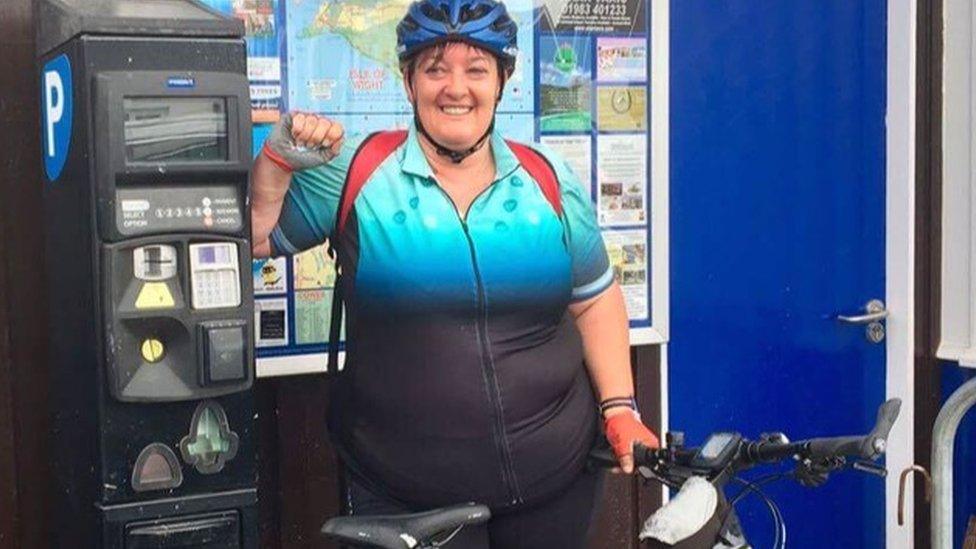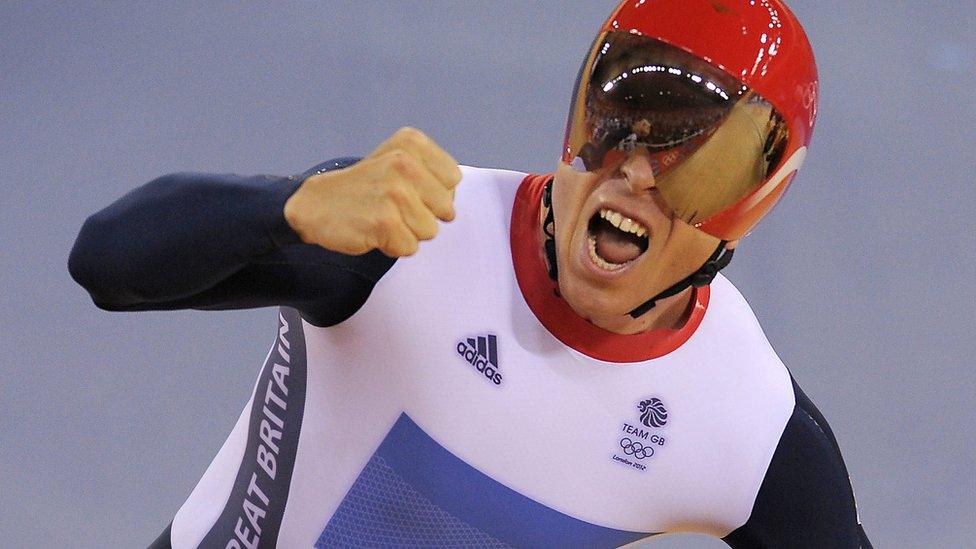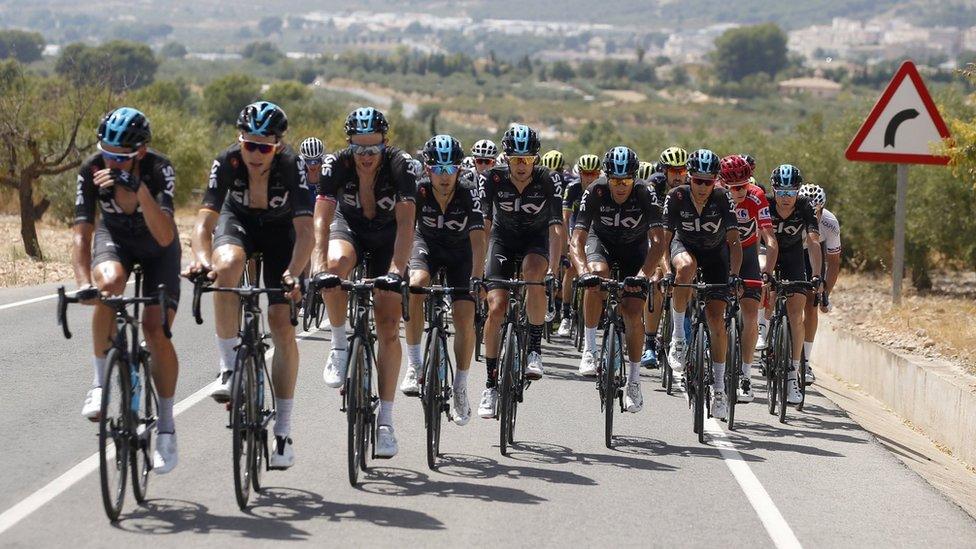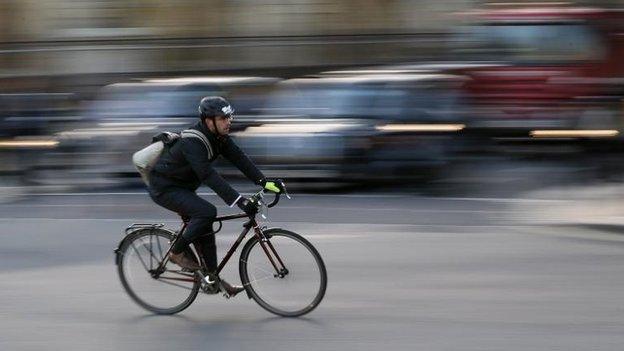Do cyclists have to be slim to wear Lycra?
- Published

Karen Wheeler says wearing Lycra makes her feel good about herself
Olympic legend Sir Chris Hoy says Lycra can look "awful" on anyone weighing more than 8st (49kg) and that amateur cyclists don't have to pull on a pair of tight-fitting shorts to look good. Is he right?
It is a question that many amateur cyclists will have asked at some point: does my belly/legs/bum* (*delete as appropriate) look big in this?
But according to Sir Chris - the six-time Olympic gold winning cyclist - not enough people think before pulling on a pair of Lycra leggings.
"Lycra isn't the most elegant material you can wear and professional cycling gear generally looks awful on pretty much anyone heavier than 8st," he wrote in GQ magazine, external.
He said the desire of so-called "mamils" - the dreaded middle-aged man in Lycra - to be seen in the latest high-performance Team Sky cycling kit all too often results in a tummy-turning experience for onlookers.
"Personally, I feel sorry for mamils," he wrote. "When they walk into a cafe dressed head-to-toe in Lycra, you always spot people sniggering at them."
So what do cyclists make of that?

Tom, right, began cycling four years ago
Tom Rochester, 48, from Norfolk, weighed almost 28st when he took up cycling four years ago.
He did so wearing a 15-year-old pair of ill-fitting rugby shorts and an equally ill-fitting T-shirt.
Tom says his cobbled together cycling outfit did nothing for his self-confidence - or help his efforts on the bike.
He believes he would have packed his bike away for good within a few weeks if he had not found something more suitable to wear.
"When I did that first 25-mile ride with a couple of thousand other cyclists all in Lycra I was conscious that although I was trying to achieve something and better myself that I was probably the most ill-dressed person there."
"There is a sense of empowerment with it," he says about pulling on his fitted Lycra outfit.
"If you feel that you look good then you are halfway there."
'Dad's old jumper'
When Karen Wheeler first started cycling four years ago, the only clothes she could find to fit her were men's extra-large clothing from Tesco.
It made her feel like she was wearing one of her dad's "old jumpers".
"I felt like I looked like a fat bird who was trying to lose weight," she says.
The 50-year-old from Chichester is a size 20 and now cycles about three times a week.
She says wearing properly fitting Lycra clothing makes her feel "like a cyclist" and is disappointed by Sir Chris's comments.
"It is about looking good and it is about how it makes you feel on your bike," she adds. "I don't actually care what everybody else thinks about me because I feel I look good in it."

Sir Chris Hoy was regularly seen in Lycra during his track cycling career
Lynn Bye co-founded Fat Lad At The Back alongside her husband, Richard.
It sells cycling clothes for the "larger lads and lasses", with items fitting people up to a 60-inch waist or chest. She says her largest items would be regarded as a XXXXXXXXXXL size in most shops.
Expecting cyclists who are overweight to be happy to wear jogging bottoms and a T-shirt on a ride is self-defeating, she says. They will get hotter more quickly than in specialist wear and can feel alienated among other riders.
"It is difficult for somebody who comes from an elite cycling background to just say 'you can wear what you want'.
"It is like a supermodel saying you can wear what you want. But to a lot of people it makes a difference."
She added: "What we have found is a lot of people want to get into cycling, they've gone out to buy an XXXL top and tried it on in the changing room and it looks ridiculous," she says.
"We find that making people feel part of the cycling community makes them feel like they belong and makes them feel like they should be doing it."

So-called mamils often look like Team Sky wannabes, Sir Chris said
However, Pete Reynolds, a blogger who writes about cycling styles, says Sir Chris's comments have a point.
Pete, who is originally from Liverpool but currently lives in Berlin, says the British attitude to cycling - and particularly about what to wear while on two wheels - is very different to the attitudes of our Continental cousins.
"If you go to other places in Europe - in Amsterdam, or Copenhagen, or here in Berlin - people are riding around in everyday clothing," he says.
"I think people in the UK see cycling as a sport rather than a means of transport," he says, adding: "I think it creates an image of cycling that is undesirable and unattainable."
He also says the sight of a cyclist in full kit may also dehumanise them.
"When people are setting out in their full gear they don't look human. In Europe it is just a person on a bike rather than 'a cyclist'."
He says there has been a mini-revolution in what is available for cyclists to wear on rides, with specialist jeans and shirts available in lighter, more suitable materials.
"In the UK, we are associating cycling with riding the Tour de France," he adds, "and it is making it seem much harder than it should be to a lot of people."
- Published24 June 2015

- Published5 November 2014
- Published14 August 2010